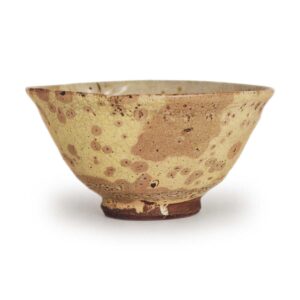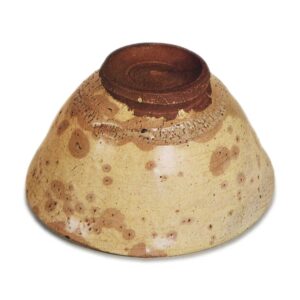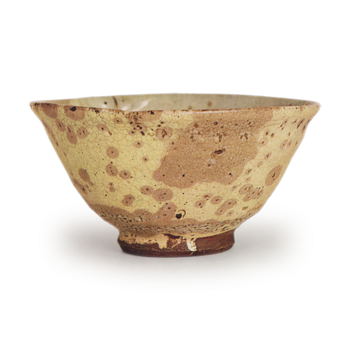

Held in the Hatakeyama Memorial Museum
Height: 7.5-8.0cm
Diameter: 14.7-15.2cm
Foot diameter: 7.1cm
Height: 1.1cm
Although it is called a “Katate teacup”, it is not as tightly fired as the “Nagasaki Katate” or “Arai” types, but is a so-called “Amamori-te” teacup, similar to the Amamori teacup in the Matsunaga Memorial Museum collection that is said to have been passed down from the Fumai family, or the Amamori teacup in the Nezu Museum collection that is said to have been passed down from the Sakai family. The tea bowl in question has a less glossy, pale, slightly yellowish, vitreous white glaze that covers the entire surface except for the foot ring, and the glaze tone seems to be closest to that of the tea bowl in the Nezu Museum that descended in the Sakai family.
It is unclear whether this type of tea bowl was considered to be a separate category from katate in ancient times, or whether tea bowls with rain-leakage-like stains on them were specifically referred to as ame-nukekate. However, in the Meibutsu-shu and Kokin Meibutsu Ruiju, there is a classification of kate, ame-nukekate, and ame-nuki, and it seems that ame-nuki was not considered to be kate. However, since rain-leakage-like stains are caused by things like tea stains permeating through cracks and holes in the glaze, they are not a word that indicates the nature of the pottery, but rather a subjective classification based on the appearance, and they are not considered to be of great significance. Therefore, it seems that a slightly stiff tea bowl with stains was called “ame-nuki-katate”, and a soft glazed tea bowl with stains was simply called “ame-nuki”. For this reason, in old box inscriptions, we often see that tea bowls with powdery stains and ame-nuki-like stains are called “ame-nuki”, rather than “powdery”.
By the way, I think that this tea bowl, along with the aforementioned Amamai’s old tea bowl and the Sakai family’s tea bowl, can be counted among the three most famous Amamai tea bowls. The overall shape is a slightly thick tea bowl, and the foot is clearly carved to look like a bamboo joint, with the foot rim chamfered. The characteristic of this tea bowl is that the rim rises in a straight line without much bulge from the foot to the rim, and the rim is slightly turned out and the edge is slightly turned inwards, so it is a tea bowl with a neat appearance that is not lacking in richness of form.
The rim is slightly distorted and there is a single crack in the kiln. The inside is deeply concave in the center, and there are four marks left from the eyes. Both the inside and outside have small and large stains scattered on the soft glaze, and there are many perforations around the base, which is probably why there are so many stains there. The clay body contains a lot of iron, and it looks dark brown.
There is a label on the lid of the box that says “Katte teacup”, but the author is not sure. According to what I have heard, it was passed down in the Konoike family, and after the war it became the property of Mr. Hatakeyama Kazukiyo, and when the Hatakeyama Memorial Museum was established, it was placed in the care of the museum.
Because it was kept in the Konoike family’s storehouse, it was not well known until today, but if it had been in the world at the time of Fumai, it is thought that it would have gained great fame, just like the tea bowls in the Matsunaga Memorial Museum, and in that sense, it would not be an exaggeration to call it a famous tea bowl of recent times.



